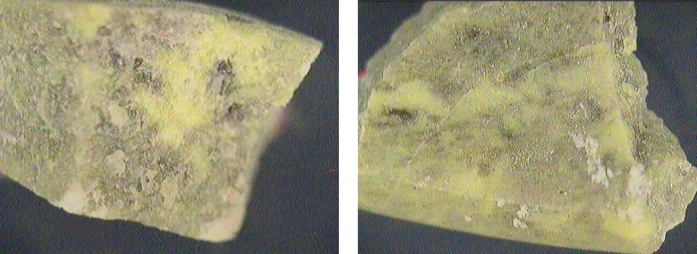Background
 Connemara Marble is unique in the sense that it is only found in one place on earth - in Galway County on the scenic west coast of Ireland. Inland from this coastal region is a series of 12 mountains known as the 12 Bens. This is where the unique marble is quarried. A combination of different types of minerals is what makes this beautiful green marble so unique. Normally, marble is composed of a limestone (CaCO₃) mineral exposed to high temperatures and pressure causing a metamorphic change in the overall texture and appearance of the rock. However, in addition to containing a limestone mineral (calcite), there are 3 other phases belonging to the serpentine mineral family found in Connemara Marble. The main polymorphic forms are chrysotile, antigorite, and lizardite. X-ray diffraction is a viable technique to identify and pinpoint the exact phase of the serpentine family.
Connemara Marble is unique in the sense that it is only found in one place on earth - in Galway County on the scenic west coast of Ireland. Inland from this coastal region is a series of 12 mountains known as the 12 Bens. This is where the unique marble is quarried. A combination of different types of minerals is what makes this beautiful green marble so unique. Normally, marble is composed of a limestone (CaCO₃) mineral exposed to high temperatures and pressure causing a metamorphic change in the overall texture and appearance of the rock. However, in addition to containing a limestone mineral (calcite), there are 3 other phases belonging to the serpentine mineral family found in Connemara Marble. The main polymorphic forms are chrysotile, antigorite, and lizardite. X-ray diffraction is a viable technique to identify and pinpoint the exact phase of the serpentine family.
Investigation
Figures 2 shows the specimens of Connemara marble that were pulverized and analyzed with the Rigaku's MiniFlex benchtop diffractometer.

The obtained diffraction pattern and the results of phase identification are shown in Figure 3 and Table 1.

|
|
|
|
|
|
|
|---|---|---|---|---|---|
| Lizardite | Mg₃ (Si₂O₅(OH)₄) | FIZ 23813 | Triclinic | C1 | 38.2 |
| Calcite | CaCO₃ | FIZ 20179 | Hexagonal | R-3C | 44.5 |
| Chlorite IIb | MgFeSiAlOOH | JCS 159 | Triclinic | C1 | 15.1 |
| Dolomite | Ca(Ca0.07Mg0.93)CO₃ | FIZ 152203 | Hexagonal | R-3 | 2.2 |
A Rietveld analysis was performed using the model obtained from these phases and quantitative results are shown in Table 1 and Fig 4 in the form of a pie chart.

